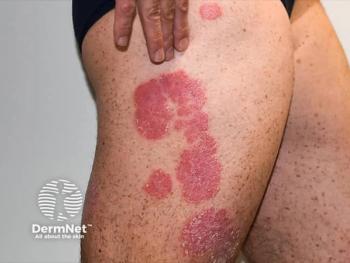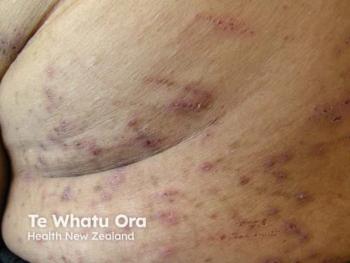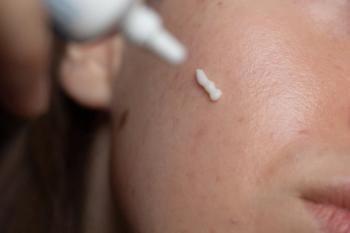
Evaluating Dupilumab and Upadacitinib for Head and Neck AD
Key Takeaways
- Upadacitinib showed superior skin clearance rates compared to dupilumab in moderate-to-severe AD, including head and neck regions.
- Patients switching from dupilumab to upadacitinib achieved significant improvements in EASI scores, particularly those initially unresponsive to dupilumab.
New research from AAD 2025 highlights upadacitinib's effectiveness over dupilumab for treating atopic dermatitis, especially in challenging facial and neck areas.
Atopic dermatitis (AD), specifically in the head and neck, is a difficult condition for patients due to the high environmental visibility and exposure. Dupilumab, a monoclonal antibody for interleukin (IL)-13 and IL-4, and upadacitinib, a selective Janus kinase 1 inhibitor (JAK1), are FDA-approved for the treatment of moderate-to-severe AD in adults and adolescents. Two posters, presented at the 2025 American Academy of Dermatology (AAD) meeting in Orlando, Florida, compared dupilumab to upadacitinib for AD and erythema of the head and neck.
The first poster featured the phase 3b/4, randomized, open-label, efficacy assessor-blinded, head-to-head, multi-center, Level Up trial (
At week 16, participants with Eczema Area Severity Index (EASI) <75 switched from dupilumab to upadacitinib 15 mg, later escalated to 30 mg if clinical response was reached. Efficacy was defined as EASI 75/90/100% improvement by body region in period 1 and 90/100% improvement (EASI 75) on the head and neck from baseline in period 2. Baseline EASI scores were 27.6 for upadacitinib and 27.1 for dupilumab.
A significantly higher proportion of patients receiving upadacitinib reached EASI 75/90/100 across all body regions versus dupilumab 2 weeks after period 1 treatment began. These response rates were maintained through week 16, including the face and neck. At week 20 (period 2), most of the patients who switched to upadacitinib after not responding to dupilumab at week 16 later achieved EASI 75. Furthermore, achievement rates increased at week 32 to 66.7%, 46.5%, and 32.7% for EASI 75/90/100. In period 2, a higher proportion of patients switching to upadacitinib achieved EASI 90 and 100.
Another study assessed the use of upadacitinib following dupilumab therapy in instances where patients experienced dupilumab-associated facial and/or neck erythema. This erythema has been reported in up to 10% of patients.2 Simpson et al. completed a systematic review on the outcomes of patients with dupilumab-associated face and neck erythema who switched from dupilumab to upadacitinib.3
Ten articles published between 2022 and 2024 on Embase and MEDLINE databases were included, reflecting 55 patients. The mean age of participants was 31.3 years, with 27 males and 18 females. The quality of each piece was assessed using the Oxford Centre for Evidence-Based Medicine 2011 Levels of Evidence.
After an average therapy duration of 8.2 weeks, all patients achieved complete (74.5%; 41/55) or partial (25.5%; 14/55) resolution of their dupilumab-associated erythema. Positive results were observed as early as 4 weeks. Compared to baseline, average EASI decreased by 85.2% (34/55) while Head and Neck Eczema Area and Severity Index (HEASI) dropped by 90% (25/55). No adverse events or erythema reoccurrences occurred. Additionally, no patients had to discontinue upadacitinib treatment. With these results, the investigators infer that dupilumab-associated face and neck erythema may be representative of other conditions like head and neck dermatitis, rosacea, psoriasiform eruptions, and allergic contact dermatitis.
Overall, emerging data presented at the 2025 AAD meeting highlights the potential advantages of upadacitinib over dupilumab for treating moderate-to-severe AD, especially in challenging regions like the head and neck. Sustained skin clearance rates with upadacitinib were reached across body regions, including in patients who did not initially respond to dupilumab. Upadacitinib also effectively resolved dupilumab-associated facial and neck erythema, suggesting a promising alternative for patients experiencing adverse reactions or inadequate response to dupilumab. While larger, long-term studies are encouraged, this current evidence supports upadacitinib as a safe and effective treatment option in these cases.
References
1. Eyerich K, Torres T, Lynde C, et al. Higher Levels of Skin Clearance Across Body Regions with Upadacitinib versus Dupilumab in Patients with Moderate-to-Severe Atopic Dermatitis. Poster presented at the 2025 American Academy of Dermatology Annual Meeting. Orlando, Florida. March 7 to 11, 2025.
2. Jo CE, Finstad A, Georgakopoulos JR, Piguet V, Yeung J, Drucker AM. Facial and neck erythema associated with dupilumab treatment: A systematic review. J Am Acad Dermatol. 2021;84(5):1339-1347. doi:10.1016/j.jaad.2021.01.012
3. Simpson R, Sood S, Waked J, et al. Outcomes of Upadacitinib Following Dupilumab for Dupilumab-Associated Facial and Neck Erythema: A Systematic Review. Poster presented at the 2025 American Academy of Dermatology Annual Meeting. Orlando, Florida. March 7 to 11, 2025.
Newsletter
Like what you’re reading? Subscribe to Dermatology Times for weekly updates on therapies, innovations, and real-world practice tips.


















